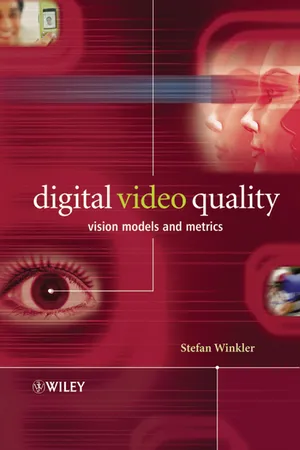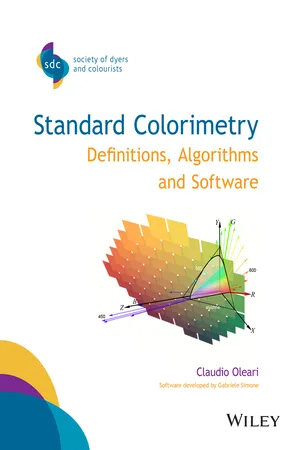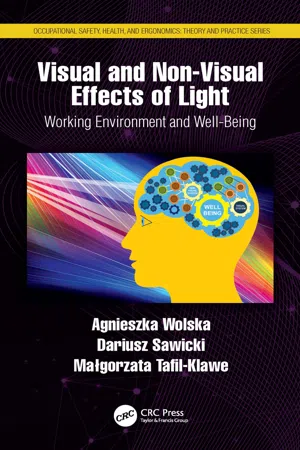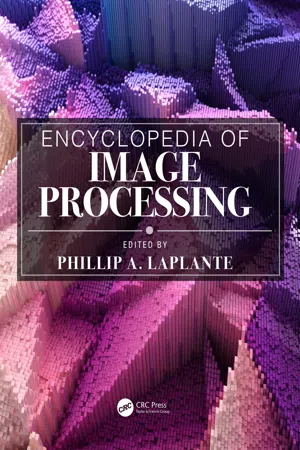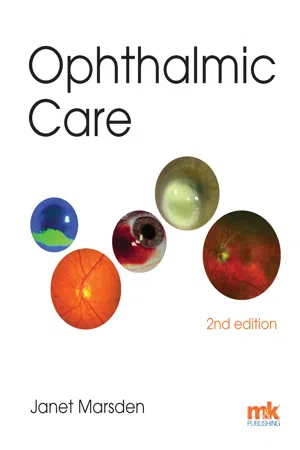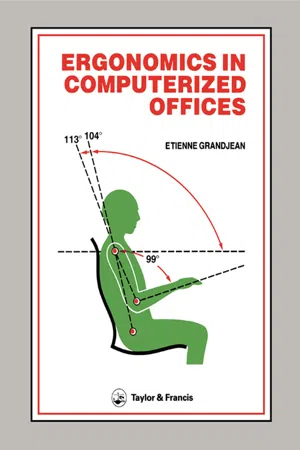Physics
Physics of Vision
The physics of vision involves the study of how light interacts with the eye and the brain to create visual perception. It encompasses the principles of optics, such as refraction and reflection, as well as the physiological processes of the eye, including the formation of images on the retina. Understanding the physics of vision is crucial for advancements in ophthalmic technology and the development of visual aids.
Written by Perlego with AI-assistance
Related key terms
Related key terms
1 of 4
Related key terms
1 of 3
8 Key excerpts on "Physics of Vision"
- eBook - ePub
Digital Video Quality
Vision Models and Metrics
- Stefan Winkler(Author)
- 2013(Publication Date)
- Wiley(Publisher)
2
Vision
Seeing is believing. English proverbVision is the most essential of our senses; 80–90% of all neurons in the human brain are estimated to be involved in visual perception (Young, 1991). This is already an indication of the enormous complexity of the human visual system. The discussions in this chapter are necessarily limited in scope and focus mostly on aspects relevant to image and video processing. For a more detailed overview of vision, the reader is referred to the abundant literature, e.g. the excellent book by Wandell (1995).The human visual system can be subdivided into two major components: the eyes, which capture light and convert it into signals that can be understood by the nervous system, and the visual pathways in the brain, along which these signals are transmitted and processed. This chapter discusses the anatomy and physiology of these components as well as a number of phenomena of visual perception that are of particular relevance to the models and metrics discussed in this book.2.1 EYE
2.1.1 Physical Principles
From an optical point of view, the eye is the equivalent of a photographic camera. It comprises a system of lenses and a variable aperture to focus images on the light-sensitive retina. This section summarizes the basics of the optical principles of image formation (Bass et al. , 1995; Hecht, 1997).The optics of the eye rely on the physical principles of refraction . Refraction is the bending of light rays at the angulated interface of two transparent media with different refractive indices. The refractive index n of a material is the ratio of the speed of light in vacuum c 0 to the speed of light in this material c : n = C 0 /c . The degree of refraction depends on the ratio of the refractive indices of the two media as well as the angle ϕ between the incident light ray and the interface normal: n 1 sin ϕ 1 = n 2 sin ϕ 2 . This is known as Snell’s law .Lenses exploit refraction to converge or diverge light, depending on their shape. Parallel rays of light are bent outwards when passing through a concave lens and inwards when passing through a convex lens. These focusing properties of a convex lens can be used for image formation. Due to the nature of the projection, the image produced by the lens is reversed, i.e. rotated 180° about the optical axis. - eBook - ePub
- Steve Marschner, Peter Shirley(Authors)
- 2018(Publication Date)
- A K Peters/CRC Press(Publisher)
Much of what we know about the eye traces back to the work of philosophers and physicists in the 1600s. Starting in the mid-1800s, there was an explosion of work by perceptual psychologists exploring the phenomenology of vision and proposing models of how vision might work. The mid-1900s saw the start of modern neuroscience, which investigates both the fine-scale workings of individual neurons and the large-scale architectural organization of the brain and nervous system. A substantial portion of neuroscience research has focused on vision. More recently, computer science has contributed to the understanding of visual perception by providing tools for precisely describing hypothesized models of visual computations and by allowing empirical examination of computer vision programs. The term vision science was coined to refer to the multidisciplinary study of visual perception involving perceptual psychology, neuroscience, and computational analysis. Vision science views the purpose of vision as producing information about objects, locations, and events in the world from imaged patterns of light reaching the viewer. Psychologists use the term distal stimulus to refer to the physical world under observation and proximal stimulus to refer to the retinal image. 1 Us-ing this terminology, the function of vision is to generate a description of aspects of the distal stimulus given the proximal stimulus. Visual perception is said to be veridical when the description that is produced accurately reflects the real world. In practice, it makes little sense to think of these descriptions of objects, locations, and events in isolation. Rather, vision is better understood in the context of the motor and cognitive functions that it serves. 20.2 Visual Sensitivity Vision systems create descriptions of the visual environment based on properties of the incident illumination - eBook - ePub
- G N Cantor, G.N. Cantor, J.R.R. Christie, M.J.S. Hodge, R.C. Olby(Authors)
- 2006(Publication Date)
- Routledge(Publisher)
40 Physical Optics G. N. Cantor DOI: 10.4324/9780203191873-471. Introduction
Aristotle understood ‘optics’ to mean the theory of the laws of sight, and for some two millenia the word was generally considered to refer to the study of how we see. Thus, until comparatively recently, lectures and textbooks addressing this subject have been concerned with the problems of visual perception; for example, how distant objects affect our eyes and (thus) our mind, the relationship between the size and situation of an object and its retinal image, the design of optical instruments and the nature of light. The subject matter of optics is thus ill-defined, spilling into areas which we would now call physiology, psychology, engineering, mathematics and physics. Moreover, throughout most of its history, optics cannot be called a discipline since, until the early nineteenth century, there were few textbooks on the subject, no journals and a small and very diverse group of practitioners. At that time, if not somewhat earlier, a more limited definition of the subject emerged, in which optics lost its association with the sense of sight and was instead taken as referring only to the study of the nature and properties of light. It is this definition which present-day physicists will recognise as a branch of their subject.1It is tempting to read the history of physical optics ‘backwards’; indeed, many historians have started with the limited physicists’ definition and then constructed a history linking the views of earlier writers concerning the nature of light. While there has certainly been some continuity within this mode of discourse, there has also been much discontinuity. For example, Descartes’ views about the nature of light cannot simply be understood as a contribution to early physics since his optical theory was framed in response to the wider problem of explaining vision. Moreover, his theory was but part of his reform of natural philosophy, from the foundations upwards. In short, his La dioptrique was but one part of his projected Le monde - eBook - ePub
Standard Colorimetry
Definitions, Algorithms and Software
- Claudio Oleari(Author)
- 2015(Publication Date)
- Wiley(Publisher)
5 Visual System 5.1 Introduction This chapter has solely an introductory purpose and, as it only considers generalities on the human visual system, the bibliography consists of textbooks, manuals and tutorials. 1–10 Only a few specialized articles are considered. Colour vision is a phenomenon consisting of a sequence of events, the disclosures of which require different tools and methodologies, which are typical of physics, bio-chemistry, physiology and psychophysics. The science of colour vision investigates all the stages of the vision phenomenon, while it is not able to measure how brain activity gives rise to the conscious experience behind colour sensations. The phenomenon of vision is activated by the colour stimulus that is an electromagnetic radiation, which is measured on the outside of the eye. The eye is the organ of vision with two functions: One function is to create on the retina an optical image of the scene external to the eye. This phenomenon is optical and regards: geometrical optics for the construction of the image on the retina and its chromatic aberrations and wave optics to define the resolution of the retinal image. The other function is retinal and concerns the generation of nerve signals, which give rise to the visual sensations in the brain. The retina is a light sensitive layer of tissues, the outside part of the nervous system, in which occurs the transduction of the luminous flux into a nerve signal. Transduction is a photochemical phenomenon and, as such, is a quantum phenomenon and the nervous signal, generated in this process, is due to the number of photons (light quanta) absorbed by the photosensitive cells of the retina - eBook - ePub
Visual and Non-Visual Effects of Light
Working Environment and Well-Being
- Agnieszka Wolska, Dariusz Sawicki, Małgorzata Tafil-Klawe(Authors)
- 2020(Publication Date)
- CRC Press(Publisher)
2 The Biological Bases of Photoreception in the Process of Image VisionA vision is not just a picture of what could be; it is an appeal to our better selves, a call to become something more. Rosabeth Moss Kanter2.1 Optics of the Eye – From the Pupil to the Retina
Numerous studies have been devoted to vision and visual perception in human beings. Though far from easy, it is important to understand the complex and still not entirely discovered workings of sight. The following chapter will try to elucidate the biology of photoreception in the process of image vision.Figure 2.1 provides a diagram showing a schematic cross-section of the human eye (A) and the morphology of the retina (B). Light enters the eye through the cornea (a transparent external surface) and passes through the pupil (the aperture that allows it in). The diameter of the pupil is controlled by the muscles of the iris so that an optimum amount of light can be let in under different conditions. Behind the iris lies the crystalline lens focusing the incoming light on the retina. Thus, the eye can be compared to a photographic camera: it has a variable aperture system (the pupil), a lens system, and a retina that corresponds to the film.FIGURE 2.1 Cross-section of the human eye (A) and morphology of the retina (B).The amount of light entering the eye through the pupil is proportional to its area. The pupil diameter in the human eye can vary from 1.5 mm to 8 mm and is regulated by the iris, whose major function is to admit more light in the dark and less in daylight. The variations in the pupil’s aperture make it capable of allowing 30-fold changes in how much light enters the eye.The lens has just the right curvature for parallel rays of light to pass through each of its parts and be bent exactly enough for all the rays to pass through a single focal point. The more a lens bends the light rays, the greater is its refractive power measured in terms of diopters. In children, this refractive power can be increased from 20 diopters to about 34 diopters, which is an accommodation of about 14 diopters. The elastic lens capsule can change shape (become more or less spherical) in response to the activity of the ciliary muscle, controlled by the autonomic nervous system. This refractive power influences visual acuity, or clarity of vision – in the human eye it is about 25 seconds of arc for discriminating between point sources of light. A person with normal visual acuity looking at two pinpoint light spots 10 m away can barely distinguish the separate spots when they are 1.5 to 2 mm apart. - eBook - ePub
- Phillip A. Laplante, Phillip A. Laplante(Authors)
- 2018(Publication Date)
- CRC Press(Publisher)
The Human Visual System Tania Pouli Technicolor, Rennes, France Erik Reinhard Technicolor Research and Innovation, Rennes, France Douglas W. Cunningham Brandenburg University of Technology, Cottbus, GermanyAbstractThis entry introduces concepts related to the human visual system and human visual perception. First, relevant radiometric and photometric terms are introduced. Then, the processing of visual signals in the retina and visual cortex are discussed. Finally, implications for human visual processing are considered.Keywords: Human visual system; Retina; Visual cortex; Visual perception.In this entry we briefly discuss the human visual system and human visual perception. We begin by defining relevant radiometric and photometric terms. Then, the human visual system is described by following light as it enters the eye and is transduced into an electrical signal by the photoreceptors. We then follow the path this signal takes through several layers of cells in the retina and onwards to the visual cortex. Although much is known about cortical visual processing, there is even more that remains unknown. We therefore describe cortical processing only at a very abstract level and only sofar as is relevant in the context of natural image statistics.In essence, the nature of human vision is such that natural images can be observed, interpreted, and understood at a level necessary to allow humans to function in a manner appropriate to their environment. Thus, this entry concludes with a discussion of the implications of visual processing.RADIOMETRIC AND PHOTOMETRIC TERMS
To be able to describe light as it is observed by humans or captured and displayed by various technologies, several important terms need to be defined. Radiometric terminology describes light as energy. Radiometry is the science of measuring optical radiation, which occurs in a range of wavelengths between 10 nm and 105 nm and includes ultraviolet, visible, and infrared radiation. Radiometric quantities are listed in Table 1 - eBook - ePub
Ophthalmic Care
2nd Edition
- Janet Marsden(Author)
- 2017(Publication Date)
- M&K Update(Publisher)
Understanding of the relationships of objects to their surroundings also develops gradually. Discrimination of distance, by means of parallactic movement, between fairly near solid objects develops before 2 months (Bower 1965). Infants then learn that they can stretch for and obtain objects within their reach, whereas they can get more distant ones only by crying for someone to give them to them. During the first year of life, infants hardly notice the existence of far-distant objects or else they may suppose that these can also be obtained by crying for them. However, once they begin to move about, infants gain a better awareness of the relative distances of further objects. The exact nature of environmental spatial relationships is not understood until the age of 6–7 years or even more. By 2 years of age, a child’s eye–hand coordination and depth perception should be well developed. Children aged 1 and 2 are very interested in exploring their environment and in looking and listening. They recognise familiar objects and pictures in books and can scribble with pencil.Thus, it is evident that perception of the environment and the objects that it contains, which occurs in older children and adults, is acquired only gradually. The processes of attention, discrimination, form perception, identification and spatial location, requiring both maturation and learning through experience, develop to some extent independently of each other and are not accurately coordinated and integrated, especially with complex precepts, until much later.Mechanisms involved in the physiology of vision The physiology of vision is a complex phenomenon. The main mechanisms involved are:Initiation of vision (phototransduction), a function of photoreceptors.Processing and transmission of visual sensation, a function of image processing cells of retina and visual pathway.Visual perception, a function of visual cortex and related areas of cerebral cortex.InitiationInitiation of vision (known as phototransduction) is when the rods and cones serve as sensory nerve endings for visual sensation. Light falling upon the retina causes photochemical changes, which in turn trigger a cascade of biochemical reactions that result in electrical impulses. Photochemical changes occur in both rods and cones which are essentially similar processes. The whole phenomenon of conversion of light energy into nerve impulse is known as phototransduction.Processing and transmission of visual impulseWhen there is an electrical activity in the photoreceptors of the retina, the direct flow of electric current passes to other cells such as horizontal cells, amacrine cells and ganglion cells. The ganglion cells then transmit the visual signals by means of action potential to the neurons of lateral geniculate body and later to the primary visual cortex. The processing of visual impulse is complicated. Visual image is deciphered and analysed in both serial and parallel manners. - eBook - ePub
- E. Grandjean(Author)
- 1986(Publication Date)
- CRC Press(Publisher)
4. Vision
4.1. The visual system
Visual perception
The eyes, acting as receptor organs, pick up energy from the outside world in the form of light waves and convert these into a form of energy that is meaningful to a living organism, i.e., into bioelectric nerve impulses. It is only through the integration of sensory impulses by the brain that we have visual perception. If the afferent sensory nerves, linking the eyes with the brain, are cut, we become blind. Perception in itself does not give a precise photocopy of the world outside: our impressions are a subjective modification of what is perceived. Thus:A particular colour seems darker when it is seen against a bright background than when it is seen against a darker background. A straight line appears distorted against a background of curved or radiating lines. A steady sensation over a long period becomes gradually weaker and can finally vanish. People differ in the intensity with which they react to visual information: an image can leave one subject indifferent while it may create great emotion in another subject.Control mechanisms
The successive stages of seeing can be simplified as follows: light rays from an object pass through the pupil aperture and converge on the retina. Here the light energy is converted into the bioelectric energy of a nerve stimulus which then passes as a nervous impulse along the fibres of the optic nerve to the brain. At a first series of intermediate nerve cells—called neurons—new impulses are generated which branch off to the centres which control the eyes, regulating the width of the pupils, the curvature of the lens and the movements of the eyeball. These control mechanisms keep the eyes continuously directed at the object, and this is automatic, i.e., not under conscious control. At the same time the original sensory impulses travel further into the brain, and after various filtering processes end up in the cerebral cortex, the seat of consciousness. Here all the signals coming from the eye are integrated into a picture of the external world. Here, too, arise new impulses which are responsible for coherent thought, decisions, feelings and reactions. These processes of the visual system are shown diagrammatically in Figure 8
Index pages curate the most relevant extracts from our library of academic textbooks. They’ve been created using an in-house natural language model (NLM), each adding context and meaning to key research topics.
Explore more topic indexes
Explore more topic indexes
1 of 6
Explore more topic indexes
1 of 4
